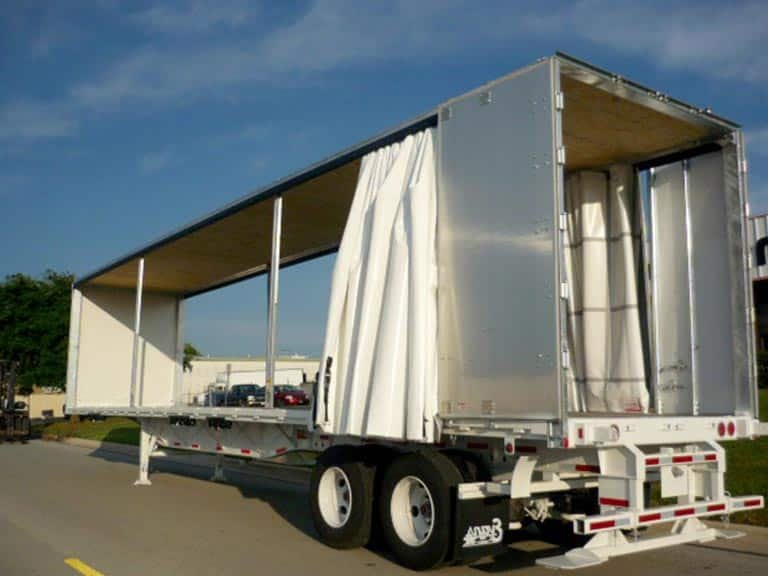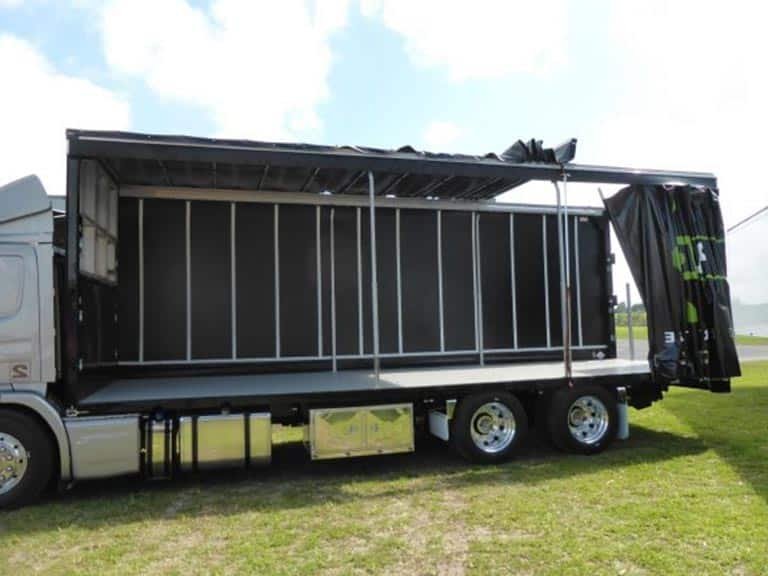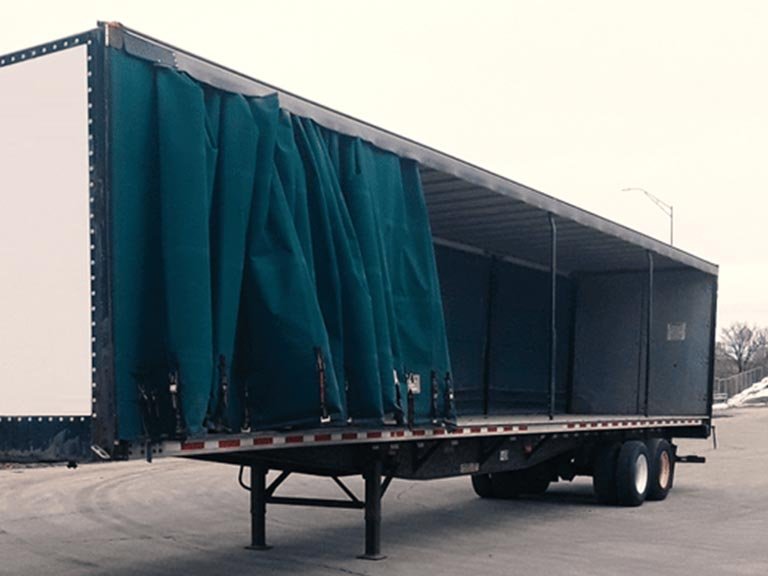¿Está seguro de que su carga estará segura durante el transporte en un remolque con lona lateral? Garantizar el transporte seguro de mercancías es una prioridad absoluta en el sector logístico. Los remolques con lona lateral ofrecen una accesibilidad excepcional, pero requieren técnicas de flejado específicas para evitar daños a la carga y mantener la seguridad vial.
En esta guía, le guiaremos a través del proceso de asegurar la carga eficazmente. Desde comprender el diseño del remolque hasta implementar técnicas de amarre profesionales.
Índice
Comprensión de los remolques con cortina lateral y sus componentes
Entonces ¿Qué es un remolque con cortina lateral?Es un remolque con lonas laterales flexibles de PVC. Las lonas laterales presentan desafíos y oportunidades únicos para la sujeción de la carga. En Genron International Trade, diseñamos remolques con lonas laterales con puntos de amarre optimizados y bastidores reforzados. Esto mejora la sujeción de la carga y maximiza la seguridad operativa.
La característica única de los remolques con cortina lateral reside en sus cortinas laterales flexibles. Estas cortinas laterales se pueden abrir completamente a lo largo del remolque, lo que proporciona una comodidad inigualable para las operaciones de carga y descarga. Esta característica de diseño, combinada con un techo y un marco de suelo rígidos, ofrece una solución versátil para diversos tipos de carga.
La sujeción eficaz de la carga en remolques con lona lateral depende de varios componentes clave. Estos incluyen puntos de amarre, barras de carga y barras separadoras. Estos elementos trabajan en conjunto para distribuir la carga uniformemente y evitar que se desplace durante el transporte.
Además, un flejado adecuado es crucial para la seguridad tanto de la carga como del remolque. Sin él, la carga puede desplazarse, lo que puede provocar accidentes, daños al producto o responsabilidades legales. Al utilizar las técnicas y el equipo de flejado adecuados, los operadores pueden garantizar un transporte seguro y exitoso.
Comience con un semirremolque a medida diseñado para sus necesidades exactas. Tanto si se trata de transporte pesado como de carga especializada, tenemos la solución perfecta para que siga avanzando.
Equipo esencial para sujetar un remolque con cortina lateral
Para asegurar la carga eficazmente, es fundamental contar con el equipo de flejado adecuado. El flejado de un remolque con lona lateral requiere una cuidadosa consideración del equipo utilizado para garantizar el transporte seguro de las mercancías.
- Tipos de correasLas correas con hebilla de trinquete o leva son lo suficientemente resistentes como para cumplir con los requisitos de resistencia de su carga útil. El límite de carga de trabajo varía según el ancho y la composición del material de la correa. Las correas van desde correas de 2 pulgadas con una capacidad de carga de 3335 libras hasta correas de alta resistencia de 4 pulgadas con una capacidad de carga de hasta 6670 libras.
- Mecanismos de trinqueteLas correas de trinquete son el estándar de la industria para asegurar la carga en remolques con cortina lateral. Suelen usar correas de poliéster y un mecanismo de trinquete especial. Los mecanismos de trinquete de alta calidad están hechos de acero al carbono con tratamiento térmico de cromado, lo que los hace duraderos y resistentes.
- Equipo de seguridad adicionalAdemás de las correas, otros equipos de sujeción, como barras de carga, protectores de esquinas, tapetes antideslizantes y protectores de bordes, se combinan para crear un sistema integral de sujeción de la carga. Al sujetar la carga, se debe usar siempre equipo de seguridad, como guantes y calzado adecuado, para proteger a los trabajadores de posibles lesiones.
Al elegir el equipo adecuado y seguir las técnicas de flejado correctas, garantizamos el transporte seguro de mercancías en remolques con lonas laterales.
Guía paso a paso para asegurar un remolque con cortina lateral
El proceso de amarre de un remolque con lona lateral implica varios pasos críticos que deben seguirse meticulosamente. Le guiaremos a través de las etapas esenciales para garantizar que su carga esté bien sujeta durante el transporte.
Preparación de su equipo y remolque
Antes de comenzar el proceso de flejado, reúna todas las herramientas y materiales necesarios. Esto incluye correas de calidad que cumplan con la carga límite de trabajo (CMT) requerida para el peso de su carga, amarres, barras de carga o palés, y equipo de seguridad como guantes. Asegurarse de que todo el equipo esté en buen estado es crucial para una sujeción segura y eficaz de la carga.

Distribución y posicionamiento adecuados de la carga
Asegúrese de que el peso de la carga esté distribuido uniformemente para mantener el equilibrio. Coloque los artículos más pesados en las secciones delantera e inferior del remolque. Los artículos más ligeros deben ir arriba. Use barras de carga para mantener la carga estable y evitar que se mueva.
Cómo asegurar la carga con correas
Para asegurar la carga es necesario identificar los puntos de amarre correctos y utilizar las técnicas correctas de colocación de correas.
- Identificación de los puntos de amarre adecuados: Localice los puntos de amarre designados por el fabricante a lo largo del chasis del remolque. Estos puntos están diseñados para soportar la resistencia a la tracción de las correas bien tensadas, garantizando una conexión segura.
- Técnicas correctas de colocación de la correa: Coloque las correas de forma que eviten el movimiento hacia adelante y hacia atrás, así como el desplazamiento lateral. Utilice una combinación de amarres directos (sujetos directamente a la carga) e indirectos (sobre la carga) para máxima seguridad.
- Métodos de trinquete y tensión: Utilice un mecanismo de trinquete para tensar las correas, eliminando cualquier holgura antes de aplicar la tensión final. Asegúrese de que la carga esté bien sujeta, pero evite apretarla demasiado, ya que podría causar daños.
| Técnica de flejado | Descripción | Beneficios |
| Amarres directos | Fijado directamente a la carga | Previene el movimiento, asegura la carga. |
| Amarres indirectos | Colocado sobre la parte superior de las cargas | Distribuye la tensión uniformemente y añade estabilidad. |
| Mecanismo de trinquete | Aprieta las correas para asegurar la carga. | La tensión ajustable evita el apriete excesivo |

Inspección final antes del tránsito
Antes de salir, realice una inspección exhaustiva para asegurarse de que todo esté bien sujeto. Compruebe la tensión de cada correa, verifique que todos los puntos de amarre estén correctamente enganchados y asegúrese de que las cortinas estén bien sujetas para proteger la carga de la intemperie.
Siguiendo estos pasos, podrá garantizar que su carga esté bien protegida, reduciendo el riesgo de daños y mejorando la seguridad vial.
Errores comunes y solución de problemas
Un flejado eficaz es crucial para el transporte seguro de la carga, pero varios errores comunes pueden comprometer la seguridad de la misma. En la industria, comprender estos problemas es clave para garantizar el transporte seguro de las mercancías y prevenir daños.
Errores frecuentes en la técnica de flejado
Uno de los errores más comunes al flejar remolques con lona lateral es subestimar la cantidad de correas necesarias. Las normas de la industria recomiendan al menos una correa por cada 680 kg de carga. Usar correas dañadas o desgastadas es otro error crítico, ya que incluso pequeñas abrasiones pueden reducir la resistencia de una correa hasta en 30%. Una tensión incorrecta, ya sea demasiado floja o demasiado apretada, causa aproximadamente 40% de problemas de sujeción de la carga.
- No usar suficientes correas. Esto aumenta el riesgo de que la carga se desplace. Se recomienda usar al menos una correa por cada 700 kg de carga.
- Usar correas dañadas. Esto puede causar daños al producto y riesgos de seguridad. Por lo tanto, revise las correas regularmente para detectar posibles daños.
- Si no se aprietan correctamente, la carga puede moverse excesivamente. Asegúrese de que las correas estén bien apretadas.

Señales de que su carga no está bien asegurada
Una correa visiblemente floja y una carga que se mueve con facilidad son señales claras de una sujeción inadecuada. Ruidos inusuales y cortinas deformadas o abultadas también indican un problema. Estos problemas ponen en riesgo la seguridad de la carga.
- Holgura visible de la correa
- Carga que se puede mover manualmente
- Ruidos inusuales durante el tránsito
- Cortinas deformadas o abultadas
Soluciones rápidas para problemas comunes de flejado
Si las correas se resbalan, vuelva a tensarlas en la siguiente parada segura. Añadir materiales antideslizantes y redistribuir la carga también puede ser útil. Para cargas desplazadas, utilice métodos de sujeción de emergencia como el uso de correas cruzadas. Los nuevos sistemas de sujeción de carga ofrecen soluciones innovadoras para estos desafíos.
Ser consciente de estos errores comunes y aplicar las soluciones adecuadas puede mejorar considerablemente la seguridad de la carga. Esto es crucial para los operadores de remolques con lonas laterales.
Conclusión
Dominar las técnicas de flejado es esencial para la seguridad en el transporte. Hemos cubierto los fundamentos de los remolques con lona, el equipo especializado necesario y cómo mantener la carga segura. Esta guía tiene como objetivo mejorar su comprensión del flejado de remolques con lona.
En Genron International Trade, nuestro Remolque con cortina lateral en venta Presenta diseños mejorados que facilitan y hacen más eficaz la sujeción de la carga. Nos dedicamos a ofrecer soluciones de remolques de alta calidad, seguras y personalizadas, equipadas con sistemas de sujeción avanzados para satisfacer sus necesidades específicas.
Al seguir las técnicas descritas e invertir en equipos de calidad, los operadores pueden reducir el riesgo de accidentes y daños a la carga. A medida que la tecnología avanza, surgen nuevas soluciones de flejado y sistemas de sujeción de carga. Un flejado eficaz es clave para proteger su negocio, su carga y la carretera.

PREGUNTAS FRECUENTES
¿Cuál es el límite de carga de trabajo de las correas utilizadas para remolques con cortina lateral?
La carga útil de las correas varía, generalmente entre 1367 y 3178 kg (3000 y 7000 libras). Consulte siempre las especificaciones del fabricante para asegurarse de que la correa sea la adecuada para su carga.
¿Con qué frecuencia debo inspeccionar mis correas y equipos de sujeción?
Las inspecciones periódicas son cruciales. Revise las correas y el equipo antes de cada uso y periódicamente durante periodos de almacenamiento prolongado o condiciones climáticas adversas.
¿Puedo utilizar cualquier tipo de correa para asegurar diferentes materiales en un remolque con cortina lateral?
No, el tipo de correa y sus especificaciones dependen del material, el peso y las dimensiones de la carga. Por ejemplo, las correas para vidrio u objetos frágiles podrían requerir un acolchado adicional o una tensión específica.
¿Cuáles son las señales de que mi carga no está bien asegurada en un remolque con cortina lateral?
Las señales de sujeción incorrecta incluyen desplazamientos o movimientos visibles de la carga durante el transporte, tensión excesiva en las correas o daños en el remolque o la carga. Las revisiones periódicas durante el transporte pueden ayudar a identificar estos problemas a tiempo.
¿Cómo distribuyo adecuadamente la carga en un remolque con cortina lateral?
Una distribución adecuada de la carga implica equilibrar el peso uniformemente a lo largo del remolque. Asegúrese de que ningún punto soporte demasiado peso y asegure la carga para evitar que se desplace. Esto mantiene la estabilidad y la seguridad durante el transporte.
¿Cuál es el papel de los mecanismos de trinquete para asegurar las cargas en los remolques con cortinas laterales?
Los mecanismos de trinquete se utilizan para tensar las correas, garantizando un ajuste firme y seguro alrededor de la carga. Proporcionan un medio para aplicar y mantener la tensión necesaria para mantener la carga en su lugar durante el transporte.


